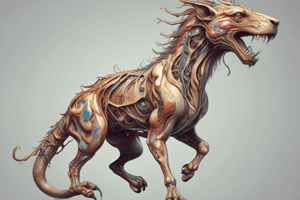Podcast
Questions and Answers
What is the primary focus of zoological anatomy?
What is the primary focus of zoological anatomy?
- Exploring the evolution of animals in different environments
- Studying animal behavior and their interactions
- Identifying and describing organ systems in animals (correct)
- Observing the physical appearance of animals
Which system controls the body's functions through sensory input and motor output?
Which system controls the body's functions through sensory input and motor output?
- Circulatory system
- Nervous system (correct)
- Digestive system
- Respiratory system
What is the main function of the skeletal system in animals?
What is the main function of the skeletal system in animals?
- Providing support, protection, and allowing movement (correct)
- Carrying out oxygen exchange
- Filtering waste materials
- Producing body heat
What does zoological anatomy involve?
What does zoological anatomy involve?
What is essential for understanding the evolution of animals and their adaptations?
What is essential for understanding the evolution of animals and their adaptations?
What is the significance of studying individual organs and cells in zoological anatomy?
What is the significance of studying individual organs and cells in zoological anatomy?
What is the main function of the digestive system?
What is the main function of the digestive system?
Which system transports blood, oxygen, and nutrients throughout the body?
Which system transports blood, oxygen, and nutrients throughout the body?
What adaptation helps animals blend in with their surroundings to avoid predators?
What adaptation helps animals blend in with their surroundings to avoid predators?
Which animals have evolved powerful muscles and bones to navigate their environment?
Which animals have evolved powerful muscles and bones to navigate their environment?
Which system secretes hormones that regulate various body functions?
Which system secretes hormones that regulate various body functions?
What do bees and ants exhibit as an adaptation for survival in their environments?
What do bees and ants exhibit as an adaptation for survival in their environments?
Which system is responsible for facilitating the exchange of gases between the body and the environment?
Which system is responsible for facilitating the exchange of gases between the body and the environment?
How do animals like owls and bats avoid predators and take advantage of food sources?
How do animals like owls and bats avoid predators and take advantage of food sources?
What is the main function of the endocrine system?
What is the main function of the endocrine system?
Which adaptation helps elephants defend themselves from predators?
Which adaptation helps elephants defend themselves from predators?
Flashcards are hidden until you start studying
Study Notes
Zoology: Exploring the Anatomy of Animals
Zoology is the branch of biology that studies animals and their characteristics, including their physical structure, behavior, and classification. In this article, we will delve into the fascinating world of zoological anatomy, exploring the anatomical features of various animals and their adaptations.
Zoological Anatomy: What is it?
Zoological anatomy is the study of the anatomical structures of animals and their functions. It involves the identification and description of organ systems, such as the circulatory, nervous, respiratory, and digestive systems, as well as the study of individual organs and cells. This field is essential for understanding the evolution of animals and their adaptations to different environments.
Animal Structures and Functions
Animals exhibit a wide range of structures and functions, which have evolved over millions of years. Some of the key anatomical features and functions found in animals include:
- Skeletal system: The skeletal system provides support and protection to the body, as well as allowing for movement through muscles attached to the bones.
- Nervous system: The nervous system controls the body's functions through the coordination of sensory input and motor output.
- Digestive system: The digestive system is responsible for breaking down food into nutrients, which are then absorbed into the bloodstream and transported to the body's cells.
- Circulatory system: The circulatory system transports blood, oxygen, and nutrients throughout the body, as well as removing waste products.
- Respiratory system: The respiratory system facilitates the exchange of gases between the body and the environment.
- Endocrine system: The endocrine system secretes hormones, which are chemical messengers that regulate various body functions.
Animal Adaptations
Animals have evolved a diverse range of adaptations to enhance their survival in different environments. Some examples of adaptations include:
- Camouflage: Many animals have developed coloration or patterns that help them blend in with their surroundings, making them harder for predators to spot.
- Physical strength: Some animals, like elephants, have evolved powerful muscles and bones to help them navigate their environment and defend themselves from predators.
- Nocturnal behavior: Animals like owls and bats have adapted to be active at night, which helps them avoid predators and take advantage of food sources that are more abundant during this time.
- Social behavior: Many animals, such as bees and ants, have developed complex social structures that help them survive and thrive in their environments.
Conclusion
Zoological anatomy is a fascinating field that provides insights into the intricate structures and functions of animals. By studying the anatomy of various species, we can gain a deeper understanding of evolution, adaptation, and the incredible diversity of life on Earth. As we continue to explore the world of zoology, we will undoubtedly uncover even more amazing adaptations and discoveries that will broaden our knowledge and appreciation for the natural world.
Studying That Suits You
Use AI to generate personalized quizzes and flashcards to suit your learning preferences.




